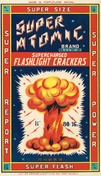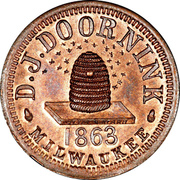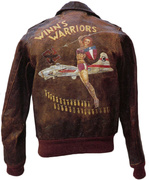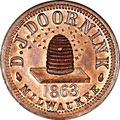
A commercially made educational toy from the 1920s, this block set has the Stars and Stripes on one side and the alphabet on the other. (Courtesy Kit Hinrichs, from Long May She Wave)
Few graphic icons hold the same visceral power as the American flag. The blue field, white stars, and red stripes have an immediate emotional impact—which is why the symbol has been so readily co-opted for everything from stage costumes to political propaganda to product advertisements.
“Reverence for the flag intensified into a civil religion with the sight of the Stars and Stripes accompanying men going off to war and draping the coffins of fallen soldiers.”
It’s easy to assume that Americans became more blasé about our sacred symbols after the Vietnam War, when the culture shifted from the anger-inducing flag-burning protests of the 1960s and ’70s to the lighthearted commercial debut of American flag Jams shorts in the ’80s. But wearing the flag as clothing, and exploiting the flag to sell your wares, goes back to the mid-19th century. Since then, the Stars and Stripes have adorned objects as wide-ranging as cigar fans, boxes of corn-salve patent medicine, Native American papoose carriers, and Nokia cell phones.
Kit Hinrichs—a celebrated graphic designer and author based in San Francisco—has collected it all. He now has more than 5,000 American flags and related memorabilia collection. Hinrichs says his patriotic obsession started decades ago when he was a young schoolboy.

Living flags were all the rage at the start of the 20th century, but arguably none was bigger than the one created on the parade ground of the U.S. Naval Training Station in Great Lakes, Illinois, in 1917. This human flag was formed by 10,000 cadets. (Courtesy Kit Hinrichs, from Long May She Wave)
“My family’s only heirloom was a tattered and patched thirty-six star Civil War flag sewn by my great-great-great aunt Ida Pepperkorn in 1865,” he writes in his 2001 book with Delphine Hirasuna and Terry Heffernan, Long May She Wave: A Graphic History of the American Flag. “My mom considered it so precious that she kept it wrapped in tissue in a sturdy department-store box, and she stored it in the safest place in the house—under her bed.”
When Hinrichs was allowed to take the flag to school for show-and-tell, “Aunt Ida’s flag received more ooohs and aaahs than the run-of-the-mill pet rabbit, horned toad, and bird’s nest,” he continues. “That was my proudest moment in first grade.” When he became the caretaker this precious flag in his 20s, he had it framed and displayed prominently in his New York City apartment.
As a designer, the inherent visual clout of the Stars and Stripes fascinated him, as well as all the permutations of the flag’s design that have popped everywhere in American culture for 150 years.

This flag salesman’s sampler was produced in 1912 to introduce the new 48-star flag. (Courtesy Kit Hinrichs, from Long May She Wave)
“By any standard, the American flag has brand value that every corporation would envy,” he writes. “In terms of pure graphic strength, the Stars and Stripes is distinct and compelling. People recognize it even in snippets of color and pattern. … I have found flags frozen in ice cream, made of broken tile and cemented in a wall, carved in tree trunks, baked in cookies, molded in Jell-O, etched in granite, made of pressed flowers, and sprinkled with red, silver, and blue glitter by a Haitian-American immigrant.”
In the book’s introduction, Gerard C. Wertkin, the former director of the American Folk Art Museum in New York City, writes that American flag motifs also appear in antique “quilts, needlework samplers, trade signs, whirligigs, weather vanes, even a sprightly megaphone.”
By now, you’ve probably heard that historians don’t believe Betsy Ross designed the first American flag. Evidence suggests the design was decided by Francis Hopkinson, a commissioner on the Continental Congress’ Navy Board, who requested (and was denied) a “quarter cask of wine” for his efforts, dismissed as “little assistances,” Wertkin explains.

During World War II, the American flag became a popular subject for weather vanes and lightning rods. (Courtesy Kit Hinrichs, from Long May She Wave)
The design was very similar to the Continental Colors, or the Grand Union Flag, already being flown by American colonists, which had 13 alternating red-and-white stripes and a canton made up of a blue field overlaid with the red cross of St. George of England and the white cross of St. Andrew of Scotland. The new flag would ditch the references to British rule and replace the crosses with a star for each colony. The Continental Congress adopted the new flag design on June 14, 1777, with little fanfare.
“By the late 1890s, the Stars and Stripes could be seen on everything from pincushions and pillowcases to clown costumes and pickled pork.”
That’s because—and this may come as a shock to you—early Americans, including the Founding Fathers, weren’t big flag-wavers. The American flag was a pesky military matter with a vital and practical purpose, to distinguish “our” ships, bases, and militias from “theirs.” Because the Flag Resolution only described the canton thusly, “the Union be thirteen stars, white in a blue field representing a new constellation,” there is significant variation among the earliest Star-Spangled Banners.
“The Founding Fathers left much undefined, including the size and number of points on each star, their arrangement on the blue field, and the width of the red and white stripes,” Wertkin writes. “As a result of this vagueness, flag makers did pretty much as they pleased, arranging stars of varying sizes, five-pointed and otherwise, in concentric circles, staggered rows, larger star patterns, geometric shapes, and random order.”

Before the flag code, product packaging took enormous liberties with America’s banner, arranging the stars in different patterns, and writing all over the flag, as we see on this trade card for United States Playing Cards by the Russell & Morgan Printing Company of Cincinnati. (Courtesy Kit Hinrichs, from Long May She Wave)
Nearly two decades after the American Revolution, the flag became a mild nuisance for Congress again, when Kentucky and Vermont became states in 1794, Wertkin explains. Replacing the flag with one of 15 stars and 15 stripes would cost a pretty penny, just for the Merchant Marines alone, but Congress resolved to do it. However, as the United States expanded westward with five states joining the Union in 1818, Congress realized the “stripe for each state” mandate would prove impractical and reverted back to 13 stripes, representing the 13 original American colonies. Between 1818 and 1912, the United States flag received 28 more stars, meaning its appearance continually changed for a century.
Perhaps the first person to get starry-eyed over the Stars and Stripes was Francis Scott Key, who wrote the poem “The Star-Spangled Banner,” after watching British warships attack Fort McHenry in Baltimore during the War of 1812. Four years later, the poem was set to the tune of the well-loved British drinking song, “To Anacreon in Heaven.”
But what Wertkin refers to as a “flag cult” didn’t start until 1861, when seven Southern States ceded from the Union, formed a new government called the Confederate States of America, and attacked the U.S. Army’s Fort Sumter in Charleston, South Carolina, on April 12, 1861, launching the Civil War. Then, the Confederate army had its own flag (which is not the so-called Rebel Flag that we think of as the Confederate flag today). American citizens declared their devotion to the original Union by waving the Star-Spangled Banner over homes, mantles, schools, churches, and chambers of commerce.

Starting in the early 20th century, patriotic needlework patterns, like the one used to make this “Solid as the Oak” pillow cover (circa 1900), could be traced from women’s magazines or purchased at department stores. (Courtesy Kit Hinrichs, from Long May She Wave)
“Reverence for the flag intensified into a civil religion with the sight of the Stars and Stripes accompanying men going off to war and draping the coffins of fallen soldiers,” Wertkin writes. “Yankee mothers even taught their daughters to make small flags—sometimes called Bible flags because they were tucked into the family Bible—to foster patriotic devotion. The Star-Spangled Banner resonated emotionally with citizens who displayed their loyalty and affection by integrating the flag motif into everyday life.”
After the war, the American Centennial of 1876, along with the Philadelphia World’s Fair that year, only solidified the newfound importance of the flag as a patriotic symbol. It was also a time when new technology, including photography and offset lithography, led to an explosion of advertising, such as tin signs, product tins and labels, trade cards, pinbacks, and paper hand fans.
“Politicians and merchants, quick to capitalize on the cult of the flag, appropriated the popular icon for their own purposes,” Wertkin writes. “Politicians printed their campaign slogans and portraits on flag banners, and merchants unabashedly wrapped their wares in flag packaging and made the Stars and Stripes part of their trademark.

In the early 20th century, Plains Indians began making souvenir gauntlet gloves based on those worn by the U.S. Cavalry. This type of floral design, as seen on these glass-beaded gloves from 1960s, was often inspired by images in magazines. (Courtesy Kit Hinrichs, from Long May She Wave)
“By the late 1890s, the Stars and Stripes could be seen on everything from pincushions and pillowcases to clown costumes and pickled pork,” he continues. “In the absence of official flag guidelines, flag makers, commercial enterprises, and private citizens were free to follow their own fancy—and did.”
“By any standard, the American flag has brand value that every corporation would envy. People recognize it even in snippets of color and pattern.”
While all these commercial and political products were bombarding the market in the late 19th century, the piously patriotic had much more lofty and solemn goals for the American flag in American culture. “Veterans groups and women’s hereditary societies embraced the flag as the vehicle for teaching young people proper moral code, patriotism, and respect for cultural institutions,” Wertkin writes.
Such groups as the Grand Army of the Republic launched into action, urged lawmakers to require that the American flag be flown at all public schools, and encouraged churches to do so as well, Wertkin explains. In 1892, Francis Bellamy wrote “The Pledge of Allegiance,” which was published in a magazine called “The Youth’s Companion” and republished on leaflets that were dispatched to schools across the United States so that all schoolchildren could read it out loud for Columbus Day celebrations. Soon, saying “The Pledge” became a daily ritual at schools, even though Congress didn’t make it official until 1942.

Dozens of American flags adorned this vintage Fourth of July parade dress. (Courtesy Kit Hinrichs, from Long May She Wave)
And of course, even back in the 1890s, “patriotic societies charged that the blatant commercial exploitation of the flag was cheapening the nation’s most revered symbol and lobbied to protect it from rampant desecration.”
To quash this crass commercialization and abuse of the proud Star-Spangled Banner, “more than two hundred flag committees were formed on local, state, and national levels to define proper flag usage by advertisers, merchants, and politicians,” Wertkin writes. “During the first quarter of the twentieth century, Congress approved a code of flag etiquette and a series of detailed design standards.”
Did it work? Well, despite all the modern rules and regulations around Old Glory, we still have American flag Hammer pants, Stars-and-Stripes bikinis, and any number of star-spangled atrocities you can name. By contrast, the mostly antique and vintage objects in Hinrichs’ flag memorabilia collection are far more beautiful and interesting to behold. But back in the day, many felt these objects—borne out of advertising, campaigning, protest, or straight-up propaganda—were just as disrespectful of the hallowed American banner.
(For more information and images from Kit Hinrichs’ American flag collection, please pick up a copy of the book “Long May She Wave: A Graphic History of the American Flag,” written and edited by Hinrichs and Delphine Hirasuna, with photographs by Terry Heffernan. If you buy something through a link in this article, Collectors Weekly may get a share of the sale. Learn more.)































 During the Civil War, Some People Got Rich Quick By Minting Their Own Money
During the Civil War, Some People Got Rich Quick By Minting Their Own Money
 Kaboom! 10 Facts About Firecrackers That Will Blow You Away
Kaboom! 10 Facts About Firecrackers That Will Blow You Away During the Civil War, Some People Got Rich Quick By Minting Their Own Money
During the Civil War, Some People Got Rich Quick By Minting Their Own Money WWII War Paint: How Bomber-Jacket Art Emboldened Our Boys
WWII War Paint: How Bomber-Jacket Art Emboldened Our Boys FlagsA flag is a piece of fabric hung from a pole or rope, usually designed to c…
FlagsA flag is a piece of fabric hung from a pole or rope, usually designed to c… Mari Tepper: Laying it on the Line
Mari Tepper: Laying it on the Line Nice Ice: Valerie Hammond on the Genteel Charm of Vintage Canadian Costume Jewelry
Nice Ice: Valerie Hammond on the Genteel Charm of Vintage Canadian Costume Jewelry How Jim Heimann Got Crazy for California Architecture
How Jim Heimann Got Crazy for California Architecture Modernist Man: Jock Peters May Be the Most Influential Architect You've Never Heard Of
Modernist Man: Jock Peters May Be the Most Influential Architect You've Never Heard Of Meet Cute: Were Kokeshi Dolls the Models for Hello Kitty, Pokemon, and Be@rbrick?
Meet Cute: Were Kokeshi Dolls the Models for Hello Kitty, Pokemon, and Be@rbrick? When the King of Comedy Posters Set His Surreal Sights on the World of Rock 'n' Roll
When the King of Comedy Posters Set His Surreal Sights on the World of Rock 'n' Roll How One Artist Makes New Art From Old Coloring Books and Found Photos
How One Artist Makes New Art From Old Coloring Books and Found Photos Say Cheese! How Bad Photography Has Changed Our Definition of Good Pictures
Say Cheese! How Bad Photography Has Changed Our Definition of Good Pictures Middle Earthenware: One Family's Quest to Reclaim Its Place in British Pottery History
Middle Earthenware: One Family's Quest to Reclaim Its Place in British Pottery History Fancy Fowl: How an Evil Sea Captain and a Beloved Queen Made the World Crave KFC
Fancy Fowl: How an Evil Sea Captain and a Beloved Queen Made the World Crave KFC
Leave a Comment or Ask a Question
If you want to identify an item, try posting it in our Show & Tell gallery.